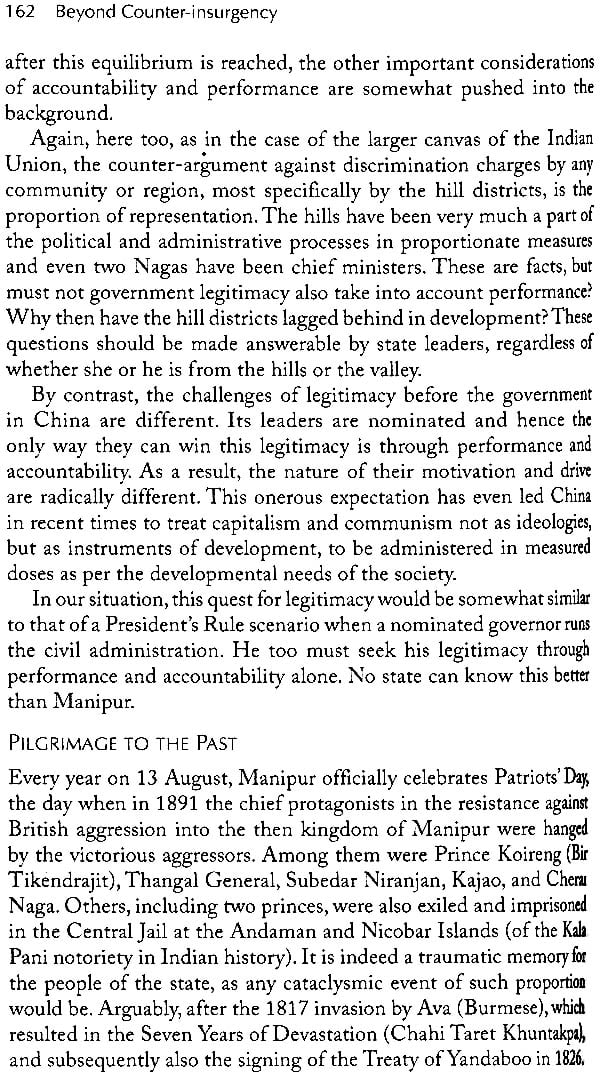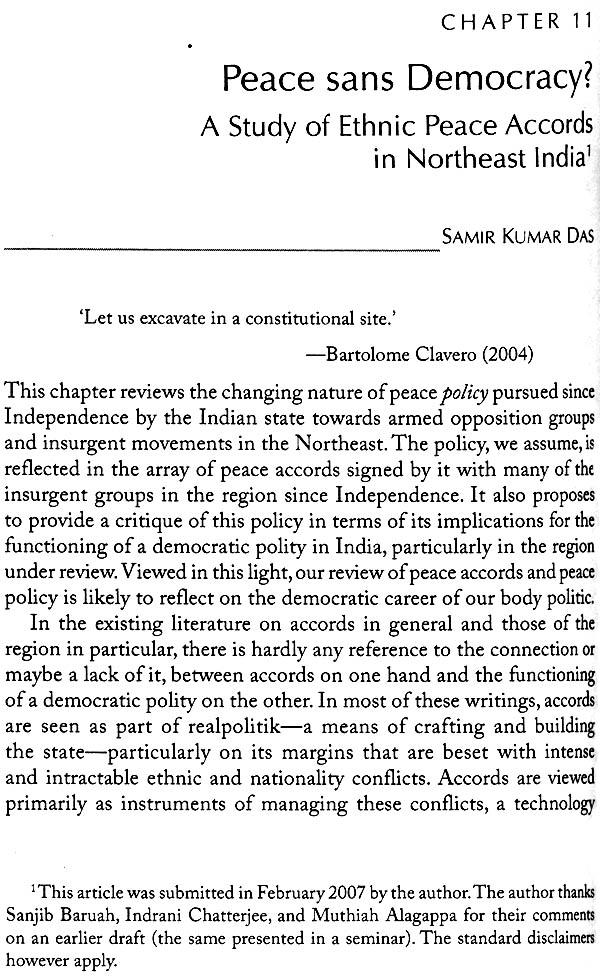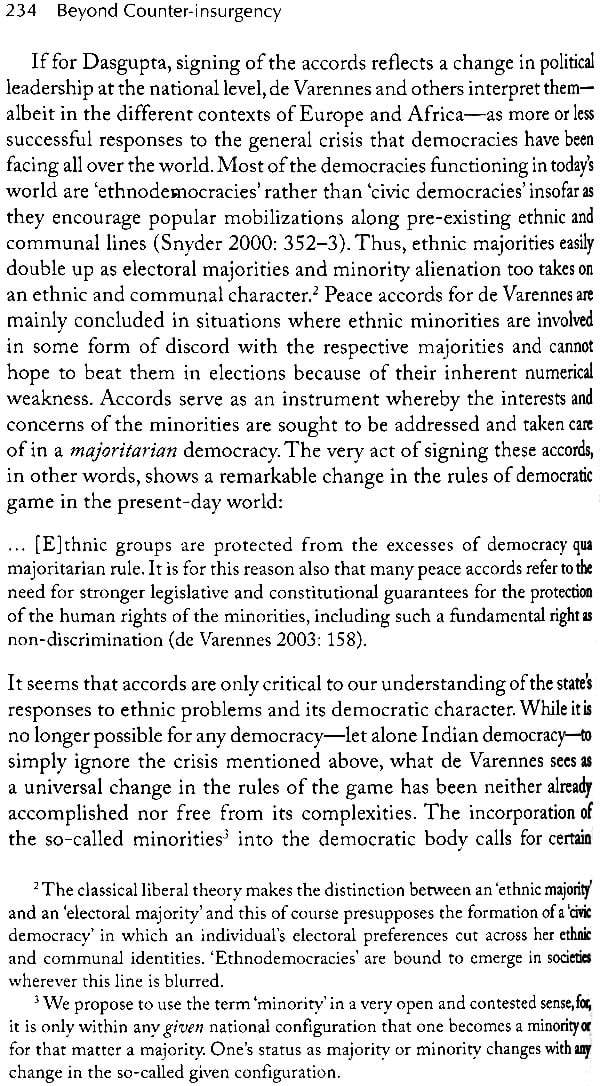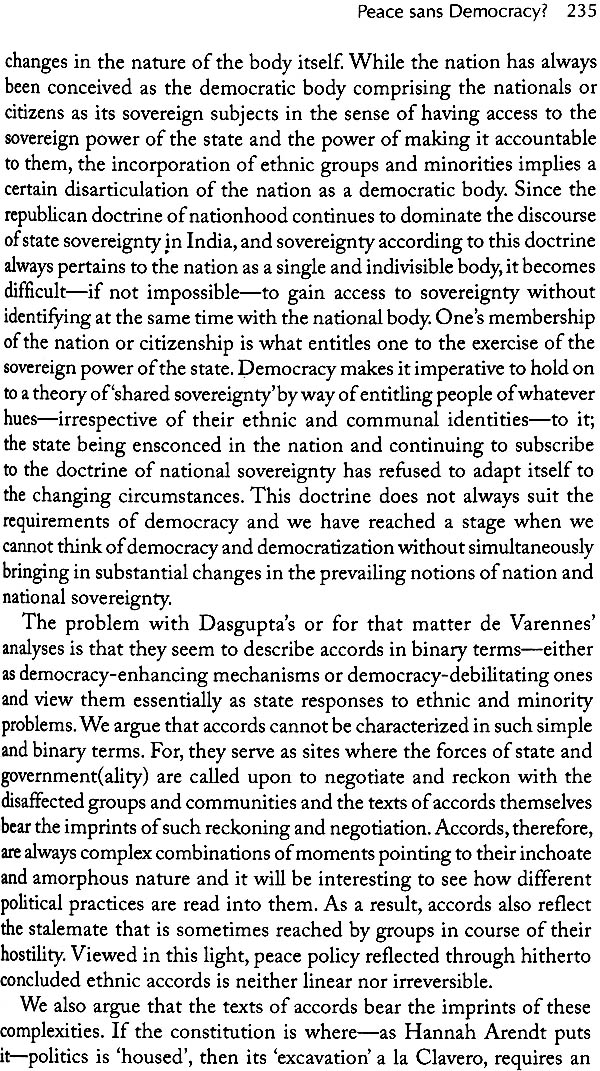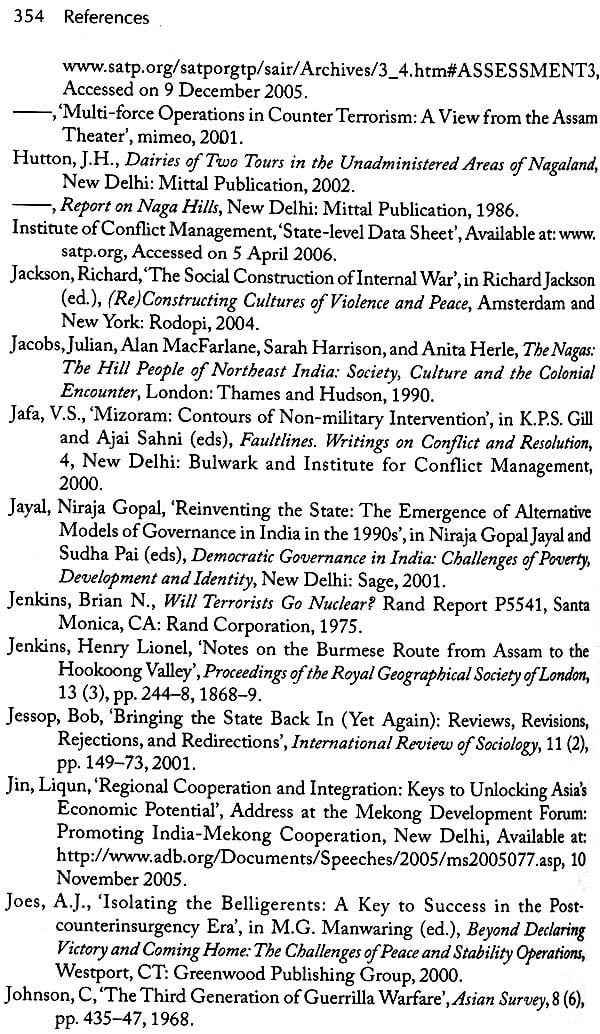
Beyond Counter-Insurgency: Breaking The Impasse in Northeast India
Book Specification
| Item Code: | NAL226 |
| Author: | Sanjib Baruah |
| Publisher: | Oxford University Press, New Delhi |
| Language: | English |
| Edition: | 2011 |
| ISBN: | 9780198078975 |
| Pages: | 405 |
| Cover: | Paperback |
| Other Details | 8.5 inch x 5.5 inch |
| Weight | 380 gm |
Book Description
Decades of armed conflicts in North-east India have militarized the region, restricted civil right, and impeded economic growth. Conveying a sense of the region’s rich and vibrant public discourse, this collection explores how democratic politics and the world of armed rebellions intersect in complex ways. A number of the contributors argue that only concerted efforts to establish the rule of law, a system of accountability, an faith in institutions of government can break the cycle of violence.
This volume will be interest to all those interested in armed conflicts, the state of Indian democracy, civil liberties, and north-east India.
Sanjib baruah is professor of Political Studies at Bard college, Annanadale-on Hudson, New York.
Indian policy towards its Northeast has seen significant reorientation in recent years. In 2001, a cabinet-level Department for Development of the North Eastern Region (DONER) was launched to put the economic development of the region on a fast track. Northeast India is the only region in the country whose development is the specific mandate of a department of the national government. Enormous public resources are being spent in trying to bridge the region's 'development gap'. There is an industrial policy in place that gives attractive tax incentives for investing in the region. The Northeast Business Summit held periodically since 2002, co-sponsored by DONER and the Indian Chamber of Commerce, showcases potential investment opportunities in the region. The Asian Car Rally and a number of similar events have drawn attention to Northeast India's future as a 'gateway to Asia', in line with the Look East policy-India's efforts to solidify diplomatic and economic ties with Southeast Asia. In 2007, India's External Affairs Minister Pranab Mukherjee visited the cities of Shillong and Guwahati in Northeast India to explain to local audiences the promises of the Look East Policy for the region. Both events were sponsored by the public diplomacy division of the Ministry of External Affairs. Rarely has a country invested so much in 'public diplomacy' at home.
The Look East Policy, in the words of a former External Affairs ministry official, 'envisages the Northeast region not as the periphery of India, but as the centre of a thriving and integrated economic space linking two dynamic regions with a network of highways, railways, pipelines, transmission lines crisscrossing the region' (Sikri 2004). The then Secretary-East of the Ministry of External Affairs, Rajiv Sikri, said that his hope was that one day it would be possible to drive from Kolkata via Dhaka, or from Guwahati to Yangon and Bangkok in three or four days, and trains and buses would carry 'millions of tourists, pilgrims, workers and businessmen in both directions' (ibid.).
Despite such ambitions, when it comes to the festering low- intensity armed conflicts of the region, there are few overt signs of a policy reorientation, or of any awareness that the persistence of armed conflicts and the existing restrictions on travel and on land and labour markets are formidable hurdles to the region becoming a 'gateway'. Yet the exceptional efforts on the part of India's foreign policy establishment to explain the benefits of the Look East Policy probably reflect the expectation that convincing the locals of those benefits would translate into reduced sympathy for the region's rebel groups. The restrictions on land and labour markets are the legacy of the boundaries drawn by British colonial rulers between spaces of law and spaces of custom. Today they serve multiple goals including national security and protective discrimination for scheduled tribes (STs).' It is hard to imagine that these restrictions would end without the political resolution of key conflicts. Yet their incompatibility with the vision of a dynamic transnational economic space is rather obvious. The hope in policy circles seems to be that counter-insurgency operations, and negotiations with leaders of insurgent groups, when feasible, would keep armed conflicts within manageable limits, until some day, development, turbo-charged by cross-border economic ties, magically trumps the conflict story. The issue of gradually removing these restrictions, it is assumed, can be safely postponed until that day.
Phrases like 'ethnic insurgencies', 'cross-border terrorism', and 'proxy wars' are the staple of Indian official talk about the Northeast, though there is no evidence that policies spelt out by this vocabulary have successfully grappled with the sources of the region's multilayered conflicts. This vocabulary also underscores tensions between the preferences of national security managers for the close monitoring of borders, and the openness of borders envisaged by a transnational economic space. The national security-centric discourse about the Northeast-shaped mostly by former bureaucrats and retired army, police, and intelligence officials-is 'heavily pro-state and insensitive to the vulnerabilities of the common man and dismissive of the frequent transgression of rights of its own citizens by the state' (Dasgupta 2004: 4469). In the scholarship on armed civil conflicts in the world-and on managing, resolving, or transforming them-there has been a virtual intellectual revolution during the past decade or so. But policy thinking in India has been mostly insulated from these debates and insights. Even the Look East Policy has, in effect, been hijacked by the military and security establishment. Unlike China that has been successful in using closer economies ties with Southeast Asia for developing its border regions, says Sushil Khanna of the Indian Institute of Management, Calcutta, comparable Indian efforts at economic integration have been lukewarm. A policy of 'opening up' has been used to 'strengthen ties with the military regimes in Bangladesh and Myanmar and launch counter-insurgency movements against the groups from North Eastern India'. Thus 'the fruits of rapid growth and closer integration with the global economy' that characterize the Indian economy in general have 'totally by-passed the border region of North East India' (Khanna 2008: 9, 14-15).
Viewed through comparative lenses, Northeast India's conflicts are of 'extraordinary duration' and the sheer number of rebel groups makes Northeast India 'an outlier by world standards' (Lacina in Chapter 15 of this volume).! Rebel groups remain active for long periods even though they know that goals like secession have little chance of success. The protracted nature of rebellions, mostly by ragtag bands of militants, makes the region a counterpoint to India's present image as a mature democracy, a dynamic economy, and an emerging global power. But thanks partly to the government's travel restrictions-for instance, research visas to foreign scholars to study Northeast India are almost never granted-the story remains marginal to the popular global image of contemporary India. While New Delhi expects the magic bullet of development to eventually come to its rescue, for the moment, in a region that is peripheral to the national imaginary, the costs of letting low-intensity conflicts proliferate and fester are seen as affordable.
| List of Photographs and Tables | VII | |
| 1 | Introduction: Sanjib Baruah | 1 |
| I. STALEMATED CONFLICTS: WHAT COST? | ||
| 2 | Resenting the Indian State: For a New Political Practice in the Northeast: Ananya Vajpeyi | 25 |
| 3 | When was the Postcolonial?- A History of Policing Impossible Lines : Bodhisattva Kar | 49 |
| II. NATION AND ITs DISCONTENTS | ||
| 4 | From Loincloth, Suits, to Battle Greens: Politics of Clothing the 'Naked' Nagas : Dolly Kikon | 81 |
| 5 | Writing Terror: Men of Rebellion and Contemporary Assamese Literature: Rakbee Kalita | 101 |
| 6 | Narrative Agency and Thinking about Conflicts: Nandana Dutta | 124 |
| III. DISCOURSES OF INCLUSION AND EXCLUSION | ||
| 7 | Northeast Problems as a Subject and Object: Pradip Phanjoubam | 147 |
| 8 | Preparing for a Cohesive Northeast: Problems of Discourse: Bhagat Oinam | 170 |
| 9 | Agency of Rioters: A Study of Decision-making in the Nellie Massacre, Assam, 1983: Makiko Kimura | 188 |
| IV. MAKING PEACE, MAKING WAR: INDIA'S PEACE POLICY | ||
| 10 | The Mizo Exception: State-Society Cohesion and Institutional Capability: M. Sajjad Hassan | 207 |
| 11 | Peace sans Democracy? A Study of Ethnic Peace Accords in Northeast India: Samir Kumar Das | 232 |
| 12 | Hills-Valley Divide as a Site of Conflict: Emerging Dialogic Space in Manipur: H. Kham Khan Suan | 263 |
| V. BREAKING THE IMPASSE | ||
| 13 | Just Development: A Strategy for Ethnic Reconciliation in Tripura : Subir Bhaumik | 293 |
| 14 | Grounds for Democratic Hope in Arunachal Pradesh: Emerging Civic Geographies and the Reinvention of Gender and Tribal Identities: Betsy Taylor | 308 |
| 15 | Rethinking Delhi's Northeast India Policy: Why neither Counter-insurgency nor Winning Hearts and Minds is the Way Forward: Bethany Lacina | 329 |
| References | 343 | |
| Notes on Contributors | 370 | |
| Index | 372 |






